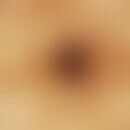Synonym(s)
HistoryThis section has been translated automatically.
DefinitionThis section has been translated automatically.
You might also be interested in
EtiopathogenesisThis section has been translated automatically.
Autosomal dominant inherited mutations of the gap junction protein beta-6gene (GJB6 gene), located on chromosome 13q11-12, leading to expression of defective connexin-30(Cx30).
ClinicThis section has been translated automatically.
Great variability, mostly mild to moderate xeroderma, besides nail dystrophies with painfully thickened, streaky, often convexly curved finger and toe nails. Very sparse, thin, short, brittle, dry hair to total alopecia; axillary and pubic hair sparse or absent, sparse cilia, thinned eyebrows in the two lateral thirds, hyperkeratoses of the palms and soles. "Knuckle pads" are described on the fingers ; also thickenings over the knees and elbows.
Optional and variable are dental anomalies with positional defects, sensory deafness, syndactyly, pincer-nails, mental retardation, short stature, photophobia and strabismus.
TherapyThis section has been translated automatically.
Symptomatic treatment after clarification of the accompanying symptoms (e.g. eyes, ears, teeth). External creams and ointments (e.g. Ungt. emulsif. aq., 2-5% urea cream R102, Basodexan cream), oil baths (e.g. Balneum Hermal, Linola fat oil bath). Avoiding desiccating measures such as long and warm showers, hot baths, etc. If necessary, keratolytic topical preparations on hands and feet such as salicylic acid ointment (e.g. Salicylvaseline Lichtenstein, R228 ).
Progression/forecastThis section has been translated automatically.
LiteratureThis section has been translated automatically.
- Clouston HR (1929) A hereditary ectodermal dystrophy. Canad Med Assoc J 21: 18-31
- Koch P et al (1995) Warty palmoplantar keratoderma as a characteristic feature of Clouston-type hidrotic ectodermal dysplasia. dermatologist 46: 272-275
- Lamartine J et al (2000) A 1.5-Mb physical map of the hidrotic ectodermal dysplasia (Clouston syndrome) gene region on human chromosomes 13q11 Genomics 67: 232-236
- Lamartine J et al (2000) Refined localization of the gene for Clouston syndrome (hidrotic ectodermal dysplasia) in a large French family. Br J Dermatol 142: 248-252
- MacKay H et al (1929) Congenital ectodermal dysplasia. Brit J Derm 41: 1-5
- Parhizkar N et al (2003) Metastatic melanoma in a patient with Clouston syndrome successfully treated with isolated hyperthermic limb perfusion. J Cutan Med Surg 7: 43-46
- Smith FJ et al (2002) A novel connexin 30 mutation in Clouston syndrome. J Invest Dermatol 118: 530-532
- Wollina U et al (1992) Hidrotic ectodermal dysplasia-trichooculodermovertebral syndrome. dermatologist 43: 158-162
Incoming links (13)
Chands syndrome; Clouston syndrome; Connexine; Ectodermal dysplasia ; Eye diseases, skin changes; GJB6 Gene; Hidrotic-ectodermal dysplasia; Hypotrichosis; Salicylic acid ointment 1/2/3/5/10 or 20% (nrf 11.43.); Trachyonychia; ... Show allOutgoing links (10)
Connexine; Ectodermal dysplasia ; GJB6 Gene; Hyperkeratosis; Knuckle pads; Mutation; Pincers-nail; Salicylic acid ointment 1/2/3/5/10 or 20% (nrf 11.43.); Urea cream hydrophilic 5 or 10% (nrf 11.71.); Xeroderma;Disclaimer
Please ask your physician for a reliable diagnosis. This website is only meant as a reference.










